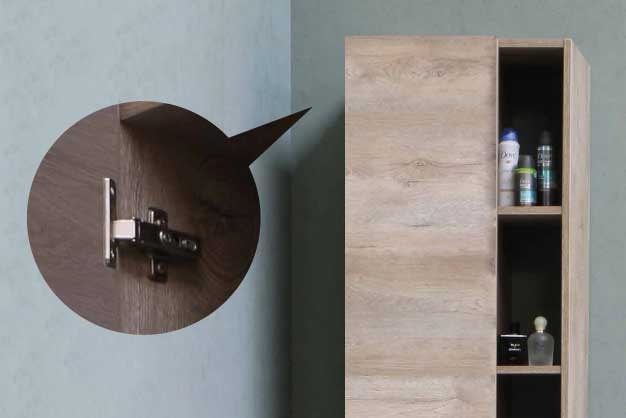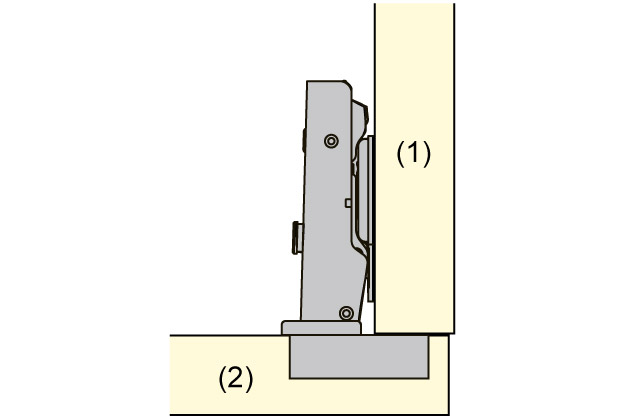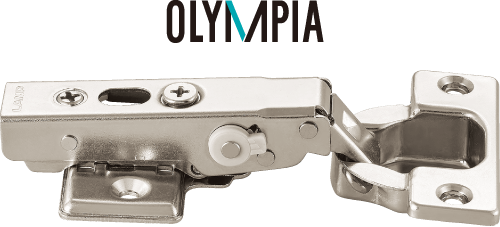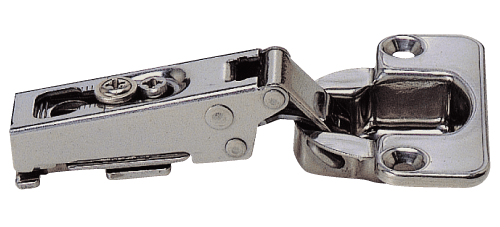Butt hinges are also used for swing doors, but have three major differences.
Firstly, concealed hinges can be installed on the interior of a cabinet. These hinges remain out of sight when the door is closed, contributing to a clean and modern appearance in line with current minimalist design trends.
Unlike traditional butt hinges, concealed hinges have multiple axes, causing the door to follow a distinctive path as it opens, slightly recessing inward.
Therefore, it can also be used in places where the wall is very close to it or where doors are lined up consecutively.
Additionally, contemporary concealed hinges feature a simple attachment and detachment mechanism. This design allows for horizontal and vertical adjustments to the door's position even after installation.
- Unternehmen Top
- About our Products
- Hardware Basics
- Concealed Hinges
Concealed (European / Cup) Hinges Hardware Basics
Concealed hinges are used for swing doors in various types of furniture and equipment.
On this page, learn the basics about different types of concealed hinges and how to choose them, including some unique options only available from Sugatsune.
Contents
What is a concealed hinge?
Concealed hinges, also called cup hinges or European style hinges, are hardware components installed on the interior side of a swing door to enable the door to open and close while also remaining hidden from the outside.


Can be used for consecutive doors

Concealed Hinges Components
Main Components:
1. Body
2. Mounting plate


The body is attached to the door, and the mounting plate is attached to the side board of the cabinet.*
Easily attach the door to the cabinet by pushing the bodies into the mounting plates and snapping them in place.
Furthermore, lifting the lever on the body will release it from the mounting plate, allowing for the door's detachment.**
*Make sure to choose a combination of body and mounting plate of the same series.
**Only applies to products with the simple attach/detach mechanism.
Video: OLYMPIA CONCEALED HINGE Attach/Detach

Types of Concealed Hinges
Door Material

When installing on wood, standard concealed hinges are used.

The optional face plate allows for installation on glass doors. Some OLYMPIA/J95 series hinges are compatible with the glass face plate.

Concealed hinges can also be used on sheet metal.
Door Overlay
The overlay refers to the area where the side panel and door overlap.
Overlays can be divided into the following three types.

(1)Side panel (2)Door
A full overlay door covers the entire face frame of cabinets.
The side panels are almost invisible when viewed from the front, allowing for a sleek design.

(1)Side panel (2)Door
An inset door is precisely fitted inside the side panels of cabinets.
Because inset doors have the ability to close at an angle greater than 90°, as they do not make contact with the side panels, it is advisable to install a door stop to prevent the door from over-closing inward.

(1)Side panel (2)Door
A half overlay cabinet door partially covers a portion of the side panels.
Half overlays are recommended for consecutive doors. As shown above, when the closing door makes contact with the side panel, it stops, eliminating the need for a door stop.

"Overlay 15~19mm (When Bore Distance is 5mm)" in our catalogue refers to the conditions shown. The "15-19mm" specification indicates that the overlay can be reduced up to -4mm with the adjustment screw.
Bore Distance refers to the distance from the edge of the door to the cup hole. The 5mm Bore Distance indicates the measurement from the door's edge to the beginning of the hinge mortise. If this distance is less than 5mm, it causes the door to move to the left, leading to a reduction in overlay and revealing part of the side panel. You can find the relevant bore distances listed in the catalogue for your convenience. Please refer to our catalogues for applicable Bore Distances.
Opening Angles

Standard opening angles.

An 85-degree door opening is recommended when walls or objects are in close proximity to the fully opened door. Standard door opening angles could lead to the door or knob making contact with these structures.
Some products with standard opening angles can be adjusted to 85° opening with additional parts.

(Wide Angles)
At wide angles, the door doesn't get in the way when items are taken in and out of storage.
Door Mechanisms
The way a door moves varies depending on the type of concealed hinge used. There are four primary types of motion.
The soft close mechanism enables doors to close slowly and quietly. It prevents sudden slamming and creates a sense of refinement to their movement.
For soft close, select concealed hinges with a built-in damper. Some types also allow for speed adjustment.
For a single door, usually two or more concealed hinges are required. However, if all of these hinges have dampers, it could result in the door closing too slowly. Certain products offer recommendations regarding the optimal number of hinges with dampers to use. Please use these recommendations as a reference.
The push open concealed hinge features a built-in spring that has force in the opening direction.
Combine it with a touch latch to create a push-to-open door. Due to the door's push-to-open mechanism, there is no need for knobs or handles.

(With Catch)
A concealed hinge with catch has a built-in spring. The spring pulls the door inward, so the door closes automatically at a certain angle. Additionally, it can assist in firmly keeping the door closed and reducing the chances of unintentional door opening.
If all concealed hinges on a single door are equipped with catches, the closing force of the door will be too strong. Combining hinges without catches and hinges with catches results in a gentler door-closing force.
(Without Catch)
A concealed hinge without a catch does not have a spring. The door does not close automatically and is not securely kept closed. Use a concealed hinge with a catch or add a separate magnetic catch to firmly keep the door in a closed position.
Colour Variations

Silver is the standard colour for concealed hinges.

Black options are available for certain concealed hinges and mounting plates.
Choose the hinge hardware to match the colour of the furniture it will be mounted on.
How to Choose Concealed Hinge Hardware
STEP 1: Select a concealed hinge
Please refer to "Types of Concealed Hinges" to choose a concealed hinge.
Use our website's filter to easily find concealed hinges that match your desired specifications by checking boxes like "Opening Angle," "Overlay Range," etc.
The number of concealed hinges per door varies based on the door's size and weight.
STEP 2: Select a mounting plate

Three types are available for some series: Plates with 2, 3, or 4 screw holes.
Mounting plates with two screw holes have a slim and sleek appearance. The difference between the three-hole and four-hole types is in their mounting strength. Please choose four-hole types for large or heavy doors.
Mounting plates with a thickness of +2mm or +5mm are available in some series and can be used to reduce the overlay.
Please refer to How to Adjust the Door Position for details.
STEP 3: Select optional items as required

Please select an optional item from the same series as the concealed hinge main body chosen in STEP1.
Design Considerations
When designing furniture with concealed hinges, the Opening Clearance (O.C) must be considered. Opening clearance (O.C) is the space required when opening and closing doors. It is very important because if it is not secured, the door will collide and not open.
Opening Clearance (B)


Clearance for
Door Edge O.C. (A)



Door Processing: Cup Diameter and Bore Depth
To mount the main body of the concealed hinge on the door, create holes similar to the ones shown in the picture. The diameter and depth of the hole are determined by the diameter (cup diameter) and depth (bore depth) of the concealed hinge cup. Find the detailed processing dimensions on each product page in the catalogue.

How to Adjust Door Position
Other Methods to Adjust Overlay
Adjusting Overlay with a Distance Plate
By inserting distance plate(s) under the mounting plate as shown in the diagram, the amount of overlay can be reduced by the thickness of the plate. For example, if you insert one 2mm thick distance plate, the overlay will decrease by 2mm, and if you use two, it will decrease by 4mm.

Adjusting Overlay with a Thicker Mounting Plate
The function of mounting plates are very similar to distance plates. By changing to a thicker mounting plate, the overlay can be reduced. For example, when you switch from the standard thickness plate to one that is +5mm thicker, the overlay will decrease by 5mm.

Concealed Hinge Series

Select from five different settings to modify the soft-close force. While JIS (Japanese Standards) mandates 40,000 cycles, OLYMPIA has exceeded this requirement by undergoing 200,000 cycles to ensure outstanding durability.

The J95 series is designed for heavy-duty applications, making it suitable for large and heavy doors. Just two J95 hinges can replace the need for five conventional hinges. Not only does create a clean aesthetic, but it also reduces installation time.

The J160 is a wide-angle heavy-duty concealed hinge. This hinge enables doors to open up to 160°, ensuring the doors remain out of the way when accessing the inside of cabinets or other storage furniture. It also a features a soft-close function.

All concealed hinges in the 100 series are made of stainless steel. Due to its excellent corrosion resistance, it is recommended for kitchen equipment and marine vessels.



